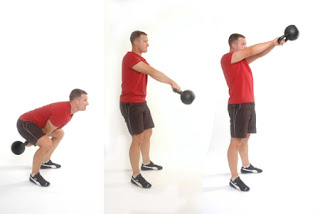Monday, January 30, 2012
Sunday, January 29, 2012
Kettlebells for Back Pain
Turning to Kettlebells to Ease Back Pain
By ANAHAD O'CONNOR - NY TimesFriday, January 27, 2012
Day 19 Purification, Workout and Food
WOW! only 2 more days and I'm done. Its been a great experience and I feel great. Ive only lost 2 lbs (wt loss was not a goal for me) so I have maintained weight and my energy throughout, despite no caffeine.
I am looking forward to pizza Sun. night and a cup of coffee Mon morning though.
Another great 6:30 am Fri workout.
We supersetted:
1.) Incline bench (4sec ecc/4 sec conc) x 10-12 w/ 1 arm cable low rows in staggered stance x 8-10 for 3
sets.
2.) 25 yd walking explosive sled push/ return puling w/ lateral plank top leg lift and
simultaneous shld abd x 10 each side for 2 sets.
3.) Alt Post rot step /cable biceps pulls x 12 w/ TRX triceps for 3 sets.
4.) Calf raises using leg pres x 10 w/ Ab wheel x10 for 3 sets.
All that in 45 mins and close to 400 cal burned.
My favorite meal today was a simple mix of brown rice, black beans red and yellow peppers, avocado and hot sauce.
If interested in the purification program let me know. It is through Standard Process. Its a whole foods based supplement co. Awesome quality and products.
Get Strong! Stay Strong!
Chris
Back Pain? Then Read This Now
Thursday, January 26, 2012
Plantar Fascia Anyone?
Don't Give In To Aging, Fight It!

One thing is for sure, you will age, but that doesn’t mean you should go “quietly.” It is widely known that exercise and diet can significantly slow the effects of aging. The problem is that many don’t follow this. Over the years it slowly creeps up on you. The pounds start accumulating, the muscles get weaker, the joints get stiffer and before you know it you are out of shape! This is often the reason why injuries and pain arise. Years of neglecting your body, the aging effect and continuing to do the same things expecting different results. Many people take better care of their pets or cars than the most valuable thing you have—your body (and mind)! One of the best things you can do is resistance train and eat sensibly. Resistance training helps to offset the loss of lean body muscle that natural decreases with aging. Loss of strength is associated with decreased function, increased risk of falling and injury. Don’t be afraid to lift heavy weights either (obviously progress to heavier weights). That means you too ladies! Don’t worry you won’t get big! You can’t, you don’t have the hormones. Anyway, studies done by the University of Miami have shown that at about the age of 50 our muscles (especially the Type II strength and power fibers) significantly begin to atrophy and if not properly stimulated will eventually become innervated by the Type I, endurance fibers, so not only do you get weaker but also slower! This then is irreversible. Scary huh? Other studies have reported that men and women lose muscle and bone mass as they age beginning at age 30. This can be off set through resistance training. Keeping your muscles functionally strong helps to decrease the aging effect, improves our ability to absorb shock, control motion, stimulate bone growth, and ultimately lead a more productive, independent and injury free life. Research has shown that it is important to lift weights at the right intensity to stimulate the Type II fibers. Light weights at higher reps are not the answer. Developing functional strength is more important for health and fitness in older adults than developing isolated muscle groups. Train movement not muscles. Don’t wait, get out there and get “fighting”! After all, aren’t you worth it? Make sure you seek qualified assistance to get you started on the right track.
Good luck and don’t stop!
Get Strong! Stay Strong!
Chris
Wednesday, January 25, 2012
Do You Have Dormant Butt Syndrome??
Get Strong! Stay Strong!
Chris
Weighted Sled For Core Training/rehab
Santa is not the only one to use a sled! The weighted sled can be used in rehab for lower extremity strength, endurance and makes a great core activator. Every patient suffering a significant injury to the lower extremity needs to restore integrated movement, strength, endurance and power. With the sled fastened around the waist and the sled towed behind leg drive and posterior chain strength can be developed for gait and transition into running. It simulates walking up hill without the hill. In addition it will get that heart rate jacked in a hurry! Walking backward will really fire up the quads. Now to use the sled for core strength and activation, I just put handles on the ends of the ropes where the waist band attaches. We can now repeat our walks holding the arms chest level or outstretched in front.
The resistance is now pulling back through the arms that have to be stabilized by the core as your legs are still driving forward, not to mention an even greater metabolic demand! Walking forward activates more of the abdominals and walking backwards (holding the handles) will activate more of the posterior core muscles. It also give you some additional bonus shoulder and arm work. A shoulder harness is a great alternative to the handles although not as demanding.
I am a big fan of asymmetrical loading due to the increased demand for stability and its relation to "real life" activity/movement. So, here are just a few of many tweaks to the sled I use.
1 arm push 1 arm pull over shld pull
So, as you can see (hopefully) these exercises can be used in rehab for the upper extremity, core or lower extremity.
Get Strong! Stay Strong!
Chris




